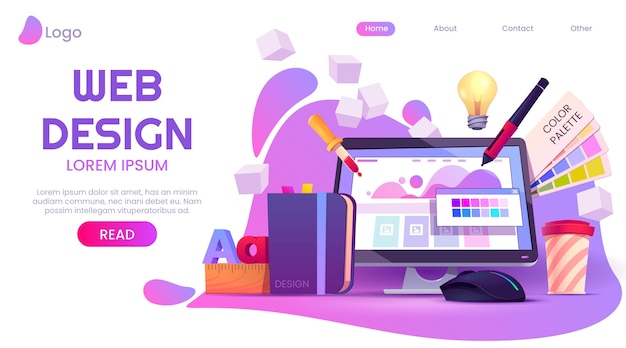Modern Website Design That Records Interest and Transforms
In a progressively electronic landscape, modern website design has actually become a pivotal factor in catching user focus and driving conversions. By tactically utilizing visual hierarchy, receptive layouts, and involving interactive elements, designers can develop experiences that not just bring in visitors but likewise help with meaningful communications. Additionally, effective call-to-action strategies play a vital role in leading users towards preferred outcomes. As we explore these essential components, it becomes clear that comprehending their interaction can considerably influence a site's efficiency and customer fulfillment. What are the crucial elements that truly make a distinction?
Relevance of Visual Hierarchy
Aesthetic pecking order is a vital aspect in web site layout, as it guides individuals' interest and improves their general experience. By purposefully organizing content, designers can direct customers to the most important information initially, consequently increasing involvement and boosting usability. Effective visual hierarchy utilizes different methods, including size, shade, contrast, and spacing. Larger aspects naturally draw the eye, while contrasting shades can emphasize essential messages, making them stand out amongst more restrained parts.
Including a logical flow in material setup is necessary; as an example, positioning one of the most crucial info on top of a web page promotes prompt acknowledgment. Constant usage of typography, such as differing font sizes and styles, assists develop a clear content structure. This organization not only aids in navigating yet additionally builds count on, as customers really feel much more comfortable when they can quickly discover what they are searching for.
Eventually, a well-executed aesthetic power structure not just improves aesthetic appeal but also dramatically affects individual habits. By prioritizing crucial aspects and making certain a smooth experience, developers can effectively transform site visitors into clients, enhancing the importance of this fundamental layout concept in modern-day site growth.
Responsive Layout for All Instruments
Developing a seamless experience throughout different gadgets is crucial in today's electronic landscape, where individuals access websites from tablet computers, mobile phones, and desktops alike. Responsive design is a vital strategy that ensures websites adjust fluidly to different screen resolutions, sizes, and positionings. By employing adaptable grids, pictures, and CSS media queries, designers can develop layouts that maintain aesthetic honesty and functionality, despite the device being made use of.
The importance of receptive style prolongs past aesthetics; it straight impacts individual engagement and conversion prices. A web site that functions well on all tools motivates longer visits and lowers bounce rates, as customers are most likely to connect with material that is very easy to navigate. Search engines, specifically Google, focus on mobile-friendly websites in their positions, making responsive style a crucial component of search engine optimization (SEO)
Including responsive layout not just boosts user experience however also streamlines the growth process. By creating a single website that works across devices, businesses can conserve time and resources contrasted to developing different mobile and desktop computer variations. Inevitably, receptive design is an essential approach for contemporary web site design, guaranteeing availability and complete satisfaction for all individuals, despite their device.
Engaging Interactive Elements
While a receptive layout prepares for a practical website, including engaging interactive elements is critical for recording customer focus and fostering deeper connections. Website Design. Interactive components, such as animations, tests, and clickable infographics, develop a much more dynamic individual experience, urging site visitors to spend even more time on the website
Including interactive functions can likewise assist individuals through complex details, making it easier to absorb material. Interactive sliders can show product variations, while ingrained videos can supply presentations or testimonies that resonate even more than static photos or message. In addition, gamification strategies, like rewards for finishing tasks or involving with content, can boost individual inspiration and retention.
Effective use of interactive elements not only improves the customer experience yet can also lead to higher conversion rates. It is necessary to stabilize interactivity with efficiency; excessively complex features might prevent website rate, adversely influencing customer complete satisfaction.
Streamlined Navigation Practices
Efficient navigation is a foundation of any type of successful website, as it directly affects customer experience and content access. Structured navigation methods ensure that individuals can conveniently locate information, boosting their interaction with the site. A well-structured navigating food selection ought to be intuitive and easy, generally including a limited number of key categories to avoid overwhelming site visitors.
To achieve structured navigation, developers should focus on a hierarchical framework that realistically arranges material. Implementing breadcrumb tracks can provide customers with context regarding their current area within the site, permitting for smooth backtracking. Additionally, using drop-down menus can efficiently preserve area while still providing accessibility to subcategories.
Receptive style is essential, as navigation should be useful across all tools (Website Design). Mobile users, in certain, take advantage of touch-friendly food selections and collapsible sections that keep functionality without endangering aesthetic appeals

Effective Call-to-Action Approaches
A well-crafted call-to-action (CTA) is crucial for assisting users towards desired results on a site, as it encourages them to involve with web content or purchase. To optimize their performance, CTAs ought to be clear, compelling, and tactically put throughout the website.
First, make use of action-oriented language that connects seriousness or value, such as "Get going," "Sign up with Currently," or "Case Your Price cut." This language not just encourages customers however likewise sets clear assumptions concerning the next steps.
2nd, think about layout elements; CTAs need to stick out visually via contrasting shades, sufficient whitespace, and prominent positioning. A button that is easy to see and click boosts the probability of user communication.
Furthermore, individualizing CTAs based upon user behavior or demographics can substantially boost engagement. Customized messages reverberate a lot more with users, driving higher conversion rates.

Conclusion
To conclude, modern site layout stresses the integration of aesthetic pecking order, receptive layouts, involving interactive components, structured navigation, and effective call-to-action techniques. These elements collectively enhance user experience, making sure that site visitors continue to be engaged and encouraged to discover content further. By prioritizing these style concepts, companies can considerably enhance customer retention and conversion prices, inevitably causing better success in the digital landscape. The continuous evolution of web design underscores its critical duty in effective online interaction and advertising and marketing.
In an increasingly electronic landscape, why not find out more contemporary web site style has actually arised as a crucial factor in catching individual focus and driving conversions.Aesthetic pecking order is a critical aspect in site design, as it guides customers' focus and boosts their total experience.The value of receptive style prolongs past aesthetics; it straight affects user interaction and conversion rates.Including responsive layout not only boosts individual experience but additionally streamlines the development procedure. Eventually, responsive style is a basic approach for contemporary website style, ensuring ease of access and satisfaction for all individuals, regardless of their gadget.